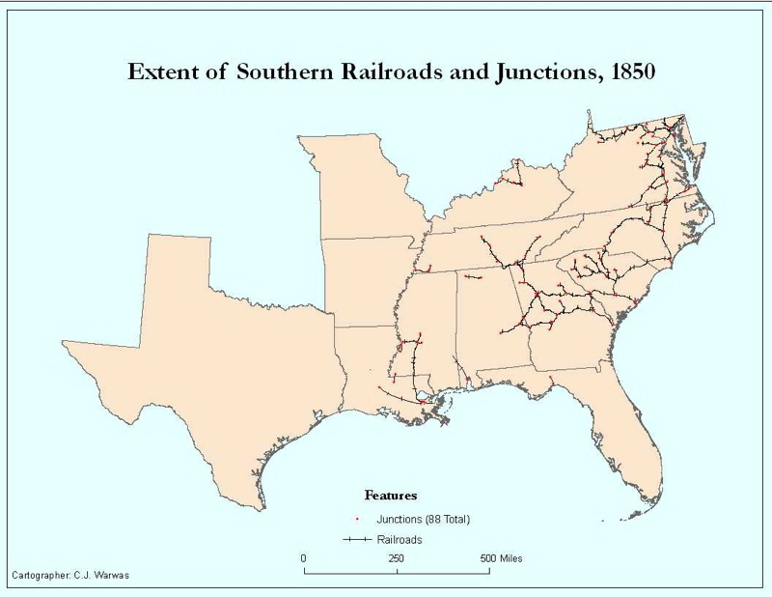Technology, Modernity, and the U.S. South before the Civil War
- Railroad Access Correlation
- Southeastern Railroad Network, April 1861, area within 10 miles of railroad
- Southern Railroads, 1850
- Southern Railroads, 1855
- Southern Railroads, 1861
- Western Borderlands Railroads, 1850
- Western Borderlands Railroads, 1861
- Cotton South Railroads, 1850
- Cotton South Railroads, 1861
- Old South Railroads, 1850
- Old South Railroads, 1861
Southern Railroads, 1850

Keywords
- Category: Language Analysis and Visualizations
- Category: Charts
- Category: Animations
- Topic: Manufacturing
One important consequence of the rush to build railroads in the South was to enhance Southern identity as distinct from the rest of the nation. For the South, the railroads united white Southerners who were separated by vast rural spaces and overcame the region’s significant natural barriers. By 1860 the most highly populated regions of the South were linked in a ways unimaginable just a generation earlier. Only western Virginia, a significant exception, stood out as a major population of white southerners out of reach of the southern-oriented rails. In the decades before the 1840s, cities in the South seemed to have little to do with one another: information rarely circulated between them, commodities were traded more to the North, especially New York, Boston, and Philadelphia, and travelers headed out of the region rather than across and within it. But the boom in railroad construction and the emergence of telegraphic communication after 1840 linked the South’s cities and created regional networks for shared information, social interaction, and trade. By 1860 people in the smaller cities and towns across the South received their information from the region’s larger cities. Even the names the railroad lines evoked a kind of formal bond or at least a fledgling relationship between distant southern places: the Memphis and Charleston, the Mississippi Central, the Savannah, Albany & Gulf, the East Tennessee and Virginia.
Historians have often dismissed Southern railroad development before the Civil War as antithetical to the plantation system of the South and indicative of the region's limited priorities. Because slavery encouraged local production of cheap goods and low consumer demand, they contend, rails carried cash crops to market, but brought little back into the plantation. The Southern railroads, these critics argue, were built with different gauges (width) of track, few of them were connected, and therefore to talk of a railroad “system” in the South was a fiction. Built to carry light loads, the argument goes, Southern railroads could not withstand the heavy hauling of the war and they broke down quickly. Southern railroad management was inefficient, fractious, and ill suited to large-scale business operations, critics have charged, and because Southern roads were laid with track produced in England or the North and operated with locomotives built and fitted out in shops outside of the South, the network, such as it was, could not be maintained in the war. One historian, Scott Reynolds Nelson has summarized, “because southern railroads relied so heavily on individual states, a ‘South’ simply did not cohere before the Civil War.” (Nelson, Iron Confederacies: Southern Railways, Klan Violence, and Reconstruction, Chapel Hill: University of North Carolina Press, 1999, pp. 16-45. For a recent treatment of the South, especially Virginia, as un-modern in its development, Susan Dunn, Dominion of Memories: Jefferson, Madison, and the Decline of Virginia, New York: Basic Books, 2007, pp. 110-112. For a traditional argument along these lines, see Robert C. Black, Railroads of the Confederacy, Chapel Hill: University of North Carolina Press, 1952, pp. 282-299.)
In retrospect, the South's self-reliance, industry, and adaptation to technologies appear surprisingly robust. The South's business and railroad leaders spoke in a language of expansion familiar to the North and they faced many of the same obstacles to financing, constructing, and running their operations. Increasingly, despite the rhetoric of national unification that accompanied the railroads, regional networks took shape in the North and South. In the South distinctive alignments knit together the slaveholding states. The expansion of railroads, it turned out, accentuated the divergent regional identities that were already taking shape. In addition, the railroads helped unify the region, creating the possiblity of a "South" where there had been local allegiances. In the South the promotion of railroads seemed to fit neatly with the idea of the South as an expansive, slaveholding, republican region.